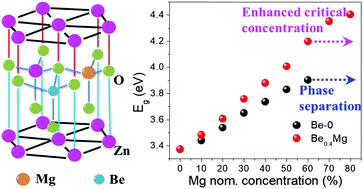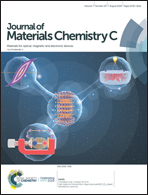Lattice restraint induced ultra-large bandgap widening of ZnO nanoparticles†
Abstract
Widening the bandgap of semiconductors in the ultraviolet (UV) region, especially in the solar-blind region, holds great potential in national defense, early warning and communication. ZnO based alloys (ZnMgO etc.) have attracted much attention due to their superiorities of intrinsic large bandgaps, facile preparation and large exciton binding energy. However, conventional strategies encounter problems of phase separation and poor crystallinity at high alloying degree. Here, by introducing Be ions into the ZnMgO nanoparticles, the crystal lattice is restrained, thereby successfully relaxing the large strain of the 'c' axis caused by the high Mg alloying degree. Then, as the critical ion concentration increases, the degree of Mg alloying increases significantly. Besides, Be co-doping also reduces the formation energy of nanoparticles with a high alloying degree and contributes to high crystallinity and low defect density. The final alloyed nanoparticles exhibit an energy gap (Eg) of 4.35 eV, which is in the solar blind region and is also the maximum of ZnO-based solution processed nano-alloys to date. This work will pave the way for ZnO based solar-blind optoelectronic devices and provide references for other material alloy systems.



 Please wait while we load your content...
Please wait while we load your content...